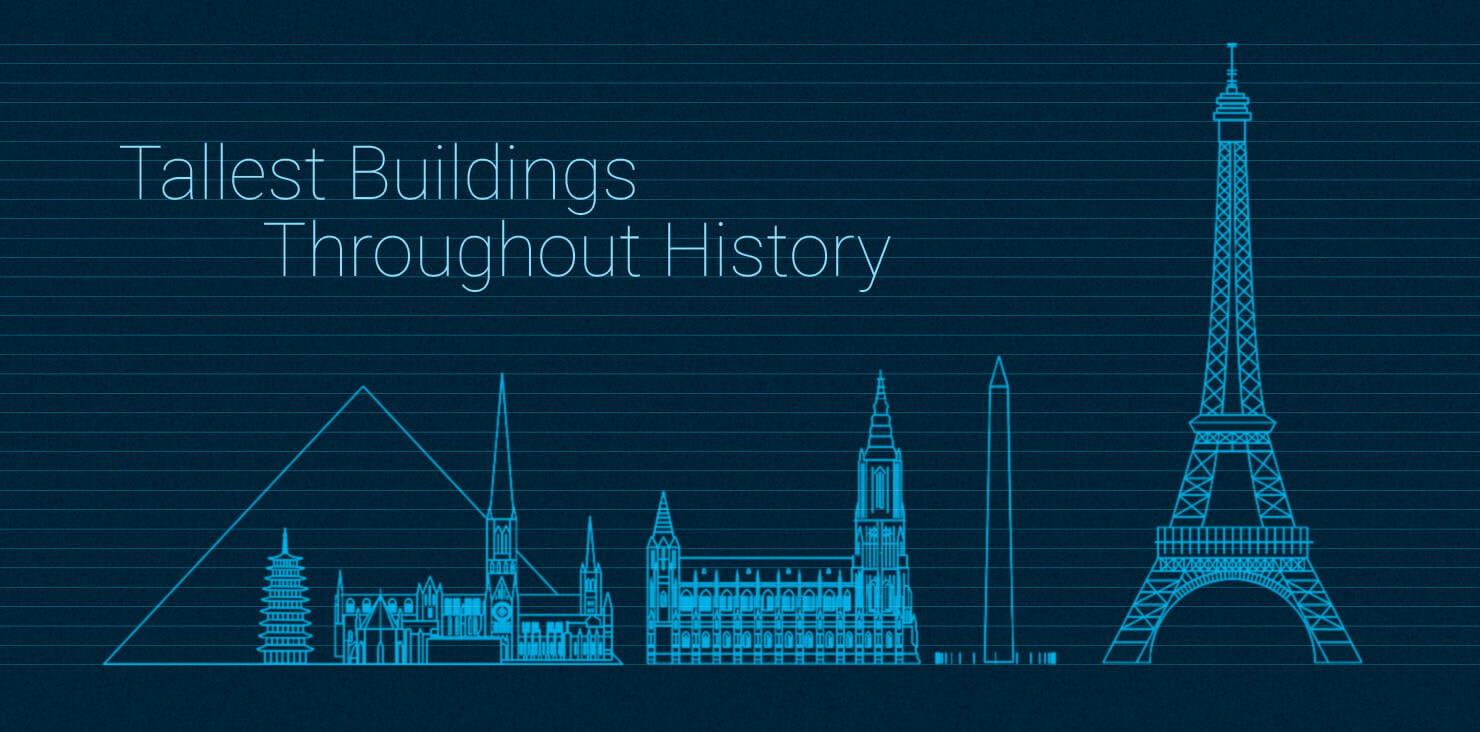Tallest Buildings
These days skyscrapers are everywhere and somewhat unremarkable. In China alone last year, 88 skyscrapers were built. But what were the tallest man-made structures to scrape the skies, long before New York cut across the skyline? Which building held the title of tallest building ever constructed for more than 579 years? The answers might surprise you.
Hwangnyongsa

Concept 3D model of Hwangryongsa made by the National Museum of Korea
Hwangnyongsa (Temple of Yellow Dragon) was a Buddhist temple in Gyeongju, South Korea. It was completed in the 569 AD during the Silla period and took 17 years to complete. There is some debate as to the exact height at which it stood, but it was 9 stories and likely to be somewhere between 68m (923 ft) and 80m (262 ft).
Many scholars created images of the temple and an archeological dig in 1969 found foundation stones for the sermon hall, auditorium, and pagoda, but the exact construction of the temple remains a mystery. It is believed to have been constructed almost entirely from wood.
The temple, much like the pyramids, is surrounded by legend and uncertainty. However, it is largely agreed that the temple was built after King Jinheung had a vision from God that instructed him to erect a temple on the site.
Lincoln Cathedral

Model of Lincoln Cathedral, as it would have looked in its hay day. Link: The Lincolnite
The pyramid of Giza 146.5m (481 ft) was the tallest man-made structure for 3,800 years. Until Lincoln Cathedral 160m (525 ft) in 1311. That's 0.4 of the height of the Empire State building! I am a Lincolnshire lass myself and therefore exceptionally pleased about this information.
Lincoln Cathedral has a rich history of falling down and being rebuilt. It is easy to identify the different time periods by the size, color, and weathering of the stonework that make up the cathedral. The cathedral was started in 1072 but caught on fire in 1124. Only to be rebuilt and destroyed in 1185 by, of all things in Lincolnshire, an earthquake. Between the years 1192 and 1235, the cathedral was again rebuilt, alas they didn't have BIM back in those days. The construction was somewhat experimental and so, just two years later, in 1237, the central Tower collapsed.
At this stage, you might think they'd give up, but no! In 1255 Henry III declared that the cathedral, once again, be rebuilt. In 1311 thanks to the wooden and lead spire on the central tower, Lincoln Cathedral became the tallest building in the world.
For 237 years the cathedral stood until disastrously, the central spire collapsed in 1548. If you consider how experimental the design was at the time, that's darn impressive. It is now a more modest 83 meters (272 ft).

The Dean's Eye on the North side of the Lincoln Tower still contains original medieval glass. Credit: © Copyright Julian P Guffogg
But Lincoln cathedral is more than just a tall building. The famous "Lincoln Imp", hidden up in the rafters, is something of a delight to children. Meanwhile, on the north and south sides, the Dean's and Bishop's Eyes cast stunning colors across the interior. Unimaginably, some of the glass remains from the original medieval building and one can imagine how visitors to the cathedral at the time would have felt God's presence.
Ulm Minster

Ulm Minster. Image link: Obernkirchener Sandstein
Impressively, Lincoln Cathedral held onto the title of the tallest building ever constructed until 1890 when it was surpassed by Ulm Minster 161.5 m (530 ft) which still remains the tallest church in the world.
To reach the top you need to take a 768 step, stone, spiral staircase. It's a tight fit and will no doubt leave you breathless, but the views are said to be spectacular.

View of the inside of the spire credit: Pekicivan
Much like the Lincoln cathedral, Ulm Minster has been rebuilt several times. It started life in 1377 and was converted from a Catholic to a protestant church in 1530. The work ground to a halt in 1543, due to lack of funding and the minster sat at a modest 100m (328ft) until 1817, when construction was restarted.
Washington Monument

Washington Monument, 1879. Construction ready to resume.
Although technically not a building, in 1884 the Washing Monument scooped the prize as the world's tallest manmade structure at 169 m (555 ft). Entirely made from stone, it remains the world's tallest all-stone structure and the tallest obelisk. It's the first building on this list that was not created for religious reasons.
Much like the Lincoln Cathedral, the Washington Monument has a noticeable change in the stone used for construction. Although assembly started in 1848, civil unrest brought the construction to a halt in 1854. When it was resumed in 1879, the marble used was sourced from a different quarry, giving the monument its characteristic stripe at the 46 m (150 ft) mark.
The Eiffel Tower

The Eiffel Tower under construction
No list of the tallest structures would be complete without a mention of the Eiffel Tower 312 m (1024 ft) smashing all previous records to smithereens in 1889. She has since gained an additional 12 m (39 ft) thanks to her radio antenna and stands as a tribute to the industrial revolution and to human engineering. Her height is taken as an average as she extends up to 17 centimeters (6.75 inches) in the sun!
No more stairs

Elisha Otis's safety-elevator patent
One of the biggest problems with early tall buildings and structures was getting to the top. I wouldn't much fancy walking up 768 steps every day and I'm sure you wouldn't either. The first elevators were notoriously unsafe and were essentially little more than cages or platforms on chains. They were used for applications such as moving goods in factories or getting workers down a mine.
All this changed in 1853 when Elisha Otis demonstrated the first elevator safety brake during the 1854 New York World's Fair. Otis famously stood on a platform and got an axeman to cut the rope. His safety brake system proved to be a huge success and the first public elevator was installed in 1857 in a 5 story department store in New York. Thus followed a race to the clouds that is still ongoing.
569 Hwangnyongsa (Temple of Yellow Dragon), 9 stories and likely to be between 68m (923 ft) and 80m (262 ft). 1311 Lincoln Cathedral 160m (525 ft), 1890 Ulm Minster 161.5 m (530 ft), 1884 the Washing Monument, 169 m (555 ft) 1853 first elevator safety brake, 1889 The Eiffel Tower 312 m (1024 ft).

